Bringing a little green into your home can have a significant impact on the atmosphere. And also, indoor plants provide a natural touch to your home decor while also enhancing your living space’s air quality.
Olive trees are popular houseplants that are relatively easy to care for, but they may require pruning and maintenance. And while growing an olive tree indoors may not be practical for most people, there are several indoor plants that look like olive trees.
These plants are easy to care for, beautiful to look at, and can add a touch of the Mediterranean to any indoor space. Read on to explore some of the best indoor plants that look like olive trees and mimic the elegant look of olive trees. You might also enjoy reading: Best And Proven Tips For Successfully Growing Olive Trees Indoors.
1- Ficus Ginseng (Ficus microcarpa ‘Ginseng’)
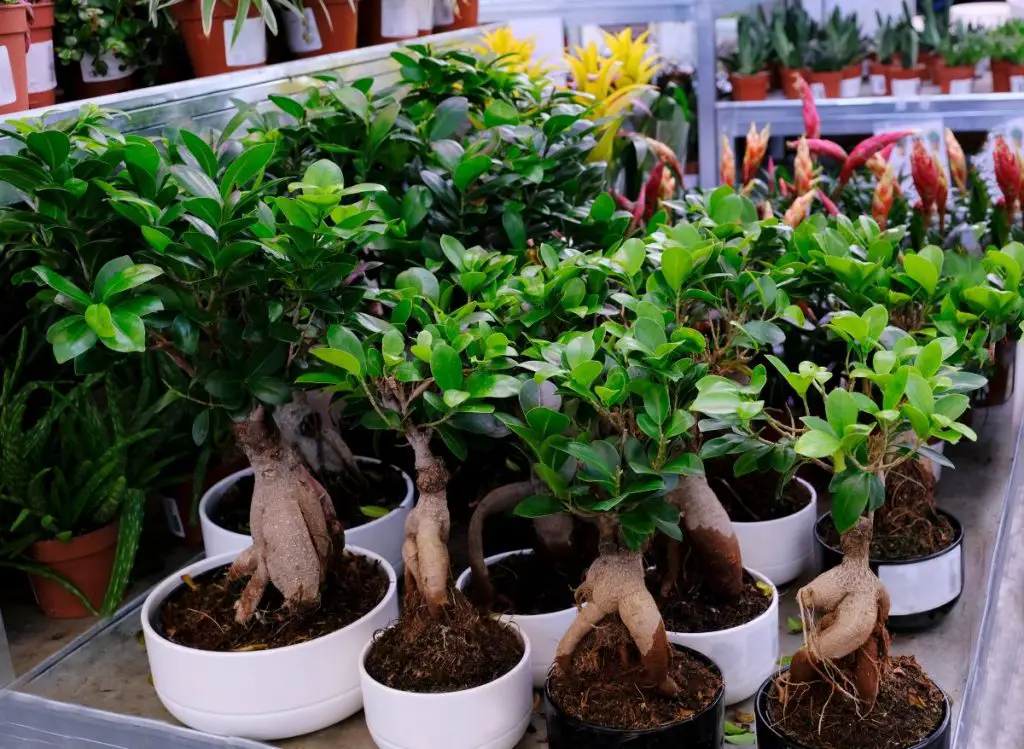
Ficus microcarpa ‘Ginseng’ is a popular indoor tree that features a thick, bulbous trunk and shiny, dark green leaves that resemble those of olive trees.
Like an olive tree, when grown outdoors in Mediterranean climates, Ficus microcarpa ‘Ginseng’ can reach 40 feet (12.2 meters) high. It also thrives in shade and is typically used as an indoor tree and in bonsai (Source: North Carolina State University)
The good news is that Ficus microcarpa ‘Ginseng’ is easy to care for and can adapt to a range of lighting conditions, making it ideal for most indoor settings. And more importantly, it is also known to purify the air, making it a great addition to any home or office.
The table below contains the growing characteristics of Ficus microcarpa ‘Ginseng’:
| Botanical Name | Ficus microcarpa ‘Ginseng’ |
| Common Name(s) | – Ficus Ginseng – Pot-bellied Ficus – Ginseng Ficus |
| Plant type | – Tree – Houseplant |
| Mature size | 40 feet (12.2 meters) high |
| Sunlight Requirement | – Ficus microcarpa ‘Ginseng’ requires full sun. – About 6 or more hours of direct sunlight per day. |
| Maintenance Requirements | Medium |
| Soil Drainage | – Moist – Good Drainage |
| Best soil texture for Ficus microcarpa ‘Ginseng’ | – Loam (Silt) – Shallow Rocky – Sand |
| Temperature Requirements | Over 68 degrees Fahrenheit throughout the year long |
2- Arbequina Olive Tree

While true olive trees may not make the best indoor plants, the Arbequina Olive Tree can flourish indoors with proper care.
Arbequina Olive Tree features gnarled trunks and small, gray-green leaves that closely resemble those of olive trees. Moreover, it requires bright light and regular watering to thrive, but it can be a beautiful and unique addition to any indoor space.
If you are interested in adding Arbequina Olive Tree to your indoor space, check out this article about growing and caring for an Arbequina olive tree.
The table below contains the growing characteristics of the Arbequina Olive Tree:
| Botanical Name | Olea europaea ‘Arbequina’ |
| Growth Rate | Moderate |
| Plant type | – Tree – Houseplant |
| Mature size | – 20 ft (6.1 meters) high |
| Sunlight Requirement | – Partial shade. – Requires full sunlight for about six hours or more daily. |
| Maintenance Requirements | Medium |
| Soil Drainage | Arbequina olive trees thrive in well-drained soil |
| Soil pH Level | pH level between 5.5 to 8.5 |
| Temperature Requirements | 60 to 68 °F (or 15 to 20 °C) throughout the year long |
3- False Olive Plant (Buddleja saligna)

The False Olive Plant, or Buddleja saligna, is a tropical evergreen that features glossy, dark green leaves and a bushy, branching habit that resembles the shape of an olive tree.
False Olive Plant plant is relatively low-maintenance and can grow up to 30 feet (about 10 meters) tall if given proper growing conditions. While it may not be well-known, the False Olive Plant can be a showstopper in any indoor garden.
The table below contains the growing characteristics of False Olive Plant (Buddleja saligna):
| Botanical Name | Buddleja saligna |
| Family | Scrophulariaceae |
| Growth Rate | Moderate |
| Plant type | – Buddleja saligna is generally easily grown from seed or cuttings |
| Mature size | Buddleja saligna grows up to 30 feet (about 10 meters) |
| Sunlight Requirement | – Partial shade. – Requires full sunlight for about six hours or more daily. |
| Maintenance Requirements | Medium |
| Soil Drainage | False Olive Plant plant thrive in well-drained soil |
| Soil pH Level | pH level between 5.5 to 8.5 |
| Temperature Requirements | 60 to 68 °F (or 15 to 20 °C) throughout the year long |
4- Satinleaf (Chrysophyllum Oliviforme)
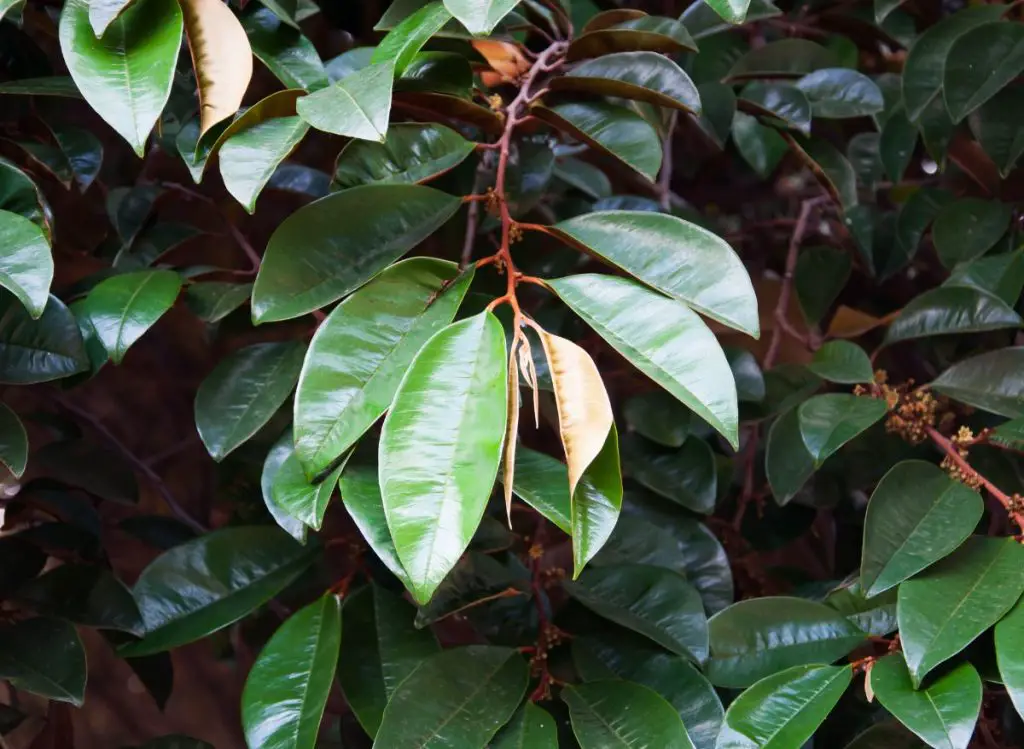
Chrysophyllum oliviforme, commonly called the satinleaf, is a medium-sized tree native to Florida with lustrous, dark green leaves.
If you want to add fresh and scented air to your space, Chrysophyllum oliviforme is a good choice as they are known to perfume a large landscape area.
The table below shows the growing characteristics of Chrysophyllum oliviforme:
| Botanical Name | Chrysophyllum oliviforme |
| Common names | Satinleaf |
| Family | Sapotaceae |
| Growth Rate | Slow |
| Plant type | Tree |
| Mature size | 35 to 45 feet (10.67 to 13.72 meters) |
| Sunlight Requirement | Full sun to partial shade |
| Maintenance Requirements | Low to medium |
| Soil Drainage | Well-drained to occasionally wet |
| Best soil type | – Clay – Sand – Loam – Alkaline – Acidic |
| USDA hardiness zones | 10 and 11. |
5- False Holly (Osmanthus heterophyllus)
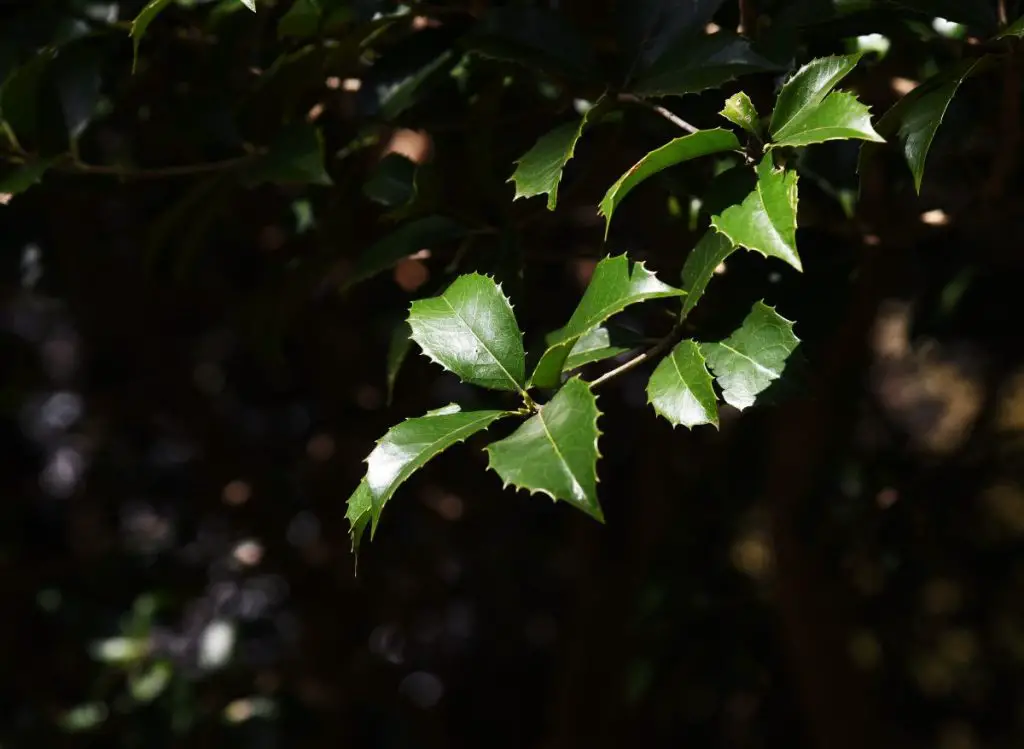
False Holly is a dense, often large, upright evergreen shrub or small tree growing 8 to 20 feet (2.44 to 6.1 meters) tall.
In general, False Holly blooms in the late fall into winter and has highly aromatic and pungently sweet, hidden flowers.
The table below shows the growing characteristics of False Holly (Osmanthus heterophyllus):
| Botanical Name | Osmanthus heterophyllus |
| Common names | – Chinese Holly – Holly Tea Olive – False Holly – Holly-leaf Osmanthus – False Olive – Holly Osmanthus – Holly Olive |
| Family | Oleaceae |
| Growth Rate | Low |
| Plant type | – Tree – Shrub |
| Mature size | 8 to 20 feet (2.44 to 6.1 meters) tall. |
| Sunlight Requirement | – Full sun for about six or more hours of direct sunlight daily. – Partial Shade meaning direct sunlight only part of the day for about 2 to 6 hours |
| Maintenance Requirements | Low |
| Soil Drainage | – Moist – Good Drainage |
| Best soil type | – Clay – Sand – Loam (Silt) |
| Potential Problems | No severe insect or disease problems. However it is recommended to watch for scale and aphids (Source: Missouri Botanical Garden) |
| USDA hardiness zones | 7 to 9 |
6- Dwarf Umbrella Tree (Schefflera Arboricola)
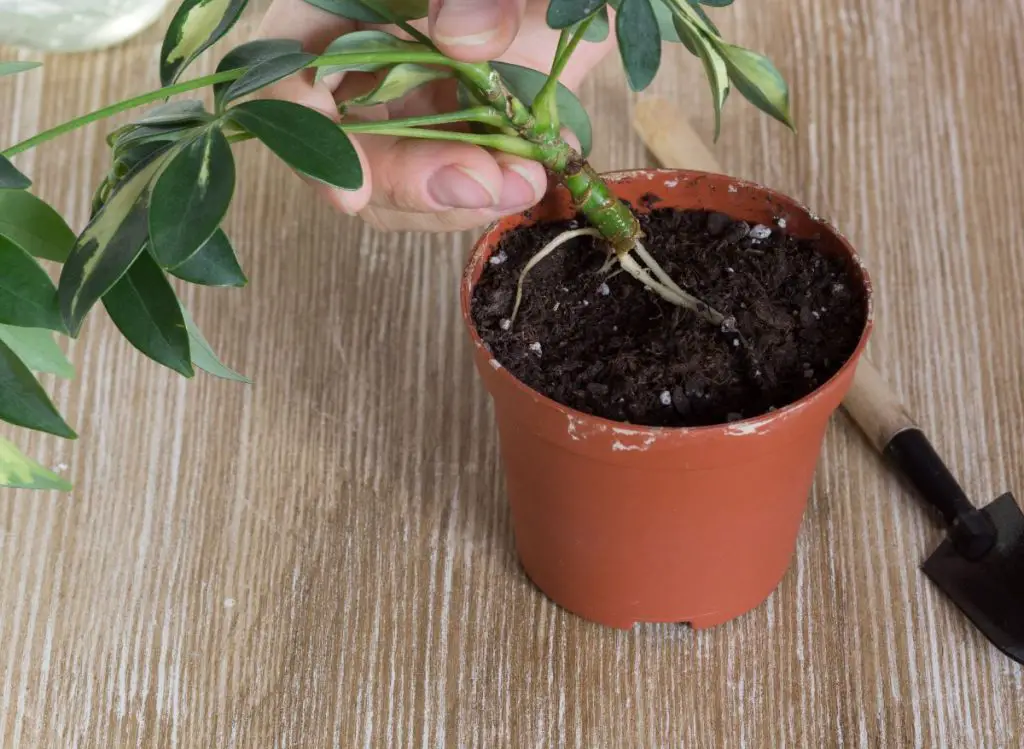
The Schefflera Arboricola, also known as the Dwarf Umbrella Tree, is a popular houseplant that features glossy, palm-like leaves and a tall, slender trunk.
The Dwarf Umbrella tree, also known as Schefflera arboricola, resembles an olive tree with its small, green leaves. It can grow up to five feet tall and can survive low light conditions. This makes it a perfect plant for small spaces that have limited natural light, such as apartments or dorms.
It is recommended to place Schefflera Arboricola in a window with slightly bright or filtered indirect light and water deeply and let it dry almost completely between watering as it does not like wet feet.
While not a perfect imitation of olive trees, this plant’s upright growth habit and shiny, dark green foliage can certainly evoke the Mediterranean aesthetic. The Dwarf Umbrella Tree is also known for its air-purifying properties.
The table below shows the growing characteristics of Dwarf Umbrella Tree (Schefflera Arboricola):
| Botanical Name | Schefflera Arboricola |
| Common names | – Australian Ivy Palm – Umbrella Plant – Dwarf Hawaiian Schefflera – Hawaiian Umbrella Tree – Dwarf Schefflera – Parasol plant |
| Family | Araliaceae |
| Growth Rate | Medium |
| Plant type | Woody |
| Mature size | 5 to 6 feet (1.52 to 1.83 meters) |
| Sunlight Requirement | – Full sun for about six or more hours of direct sunlight per day. – Partial Shade for about 2 to 6 hours |
| Maintenance Requirements | Low |
| Soil Drainage | – Good Drainage – Occasionally Dry – Moist |
| Best soil type | – Loam (Silt) |
| Potential Problems | – Similar to olive tree, Schefflera Arboricola is Relatively disease and pest-free – Watch for aphids, mealybugs, thrips, and spider mites, as they can sometimes be a problem a. – Wet soil also promotes disease. |
| USDA hardiness zones | 10 to 12 |
7- Blue Quandong (Elaeocarpus grandis)
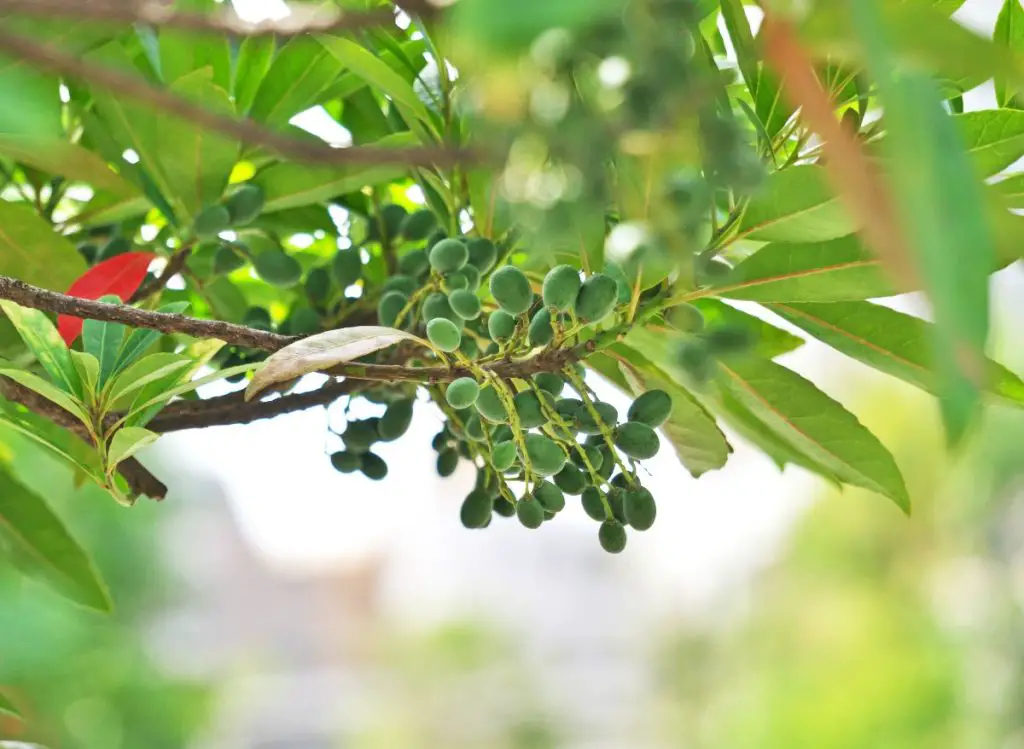
Blue Quandong, or Elaeocarpus grandis, is a striking indoor plant that features small, oval-shaped leaves with a deep, glossy green color. The tree can grow up to 164 feet tall in the tropics, but it is smaller in cooler areas and requires bright, indirect light to thrive.
While it may not be as well-known as other indoor plants, the Myanmar Olive Tree is a unique and beautiful addition to any indoor garden.
The table below shows the growing characteristics of Blue Quandong (Elaeocarpus grandis):
| Botanical Name | Elaeocarpus angustifolius |
| Common names | – Silver Quandong – White Quandong – Brush Quandong – Brisbane Quandong – Blueberry Ash – Blue Quandong – Blue Fig |
| Family | Elaeocarpaceae |
| Maintenance Requirements | – Low maintenance garden and grow well in a container |
| Plant type | – Small tree – Large tree |
| Mature size | – Grow up to 164 feet tall in the tropics – But it is smaller in cooler areas |
| Sunlight Requirement | – Half shade – Sunny – Light shade, |
| Maintenance Requirements | Low |
| Soil Drainage | – Moist moderate drainage – Well-drained |
| Best soil type | – Sandy loam – Loamy – Clay loam |
| Potential Problems | It might attracts Wildlife when left outside |
8- Rubber Plant (Ficus elastica)
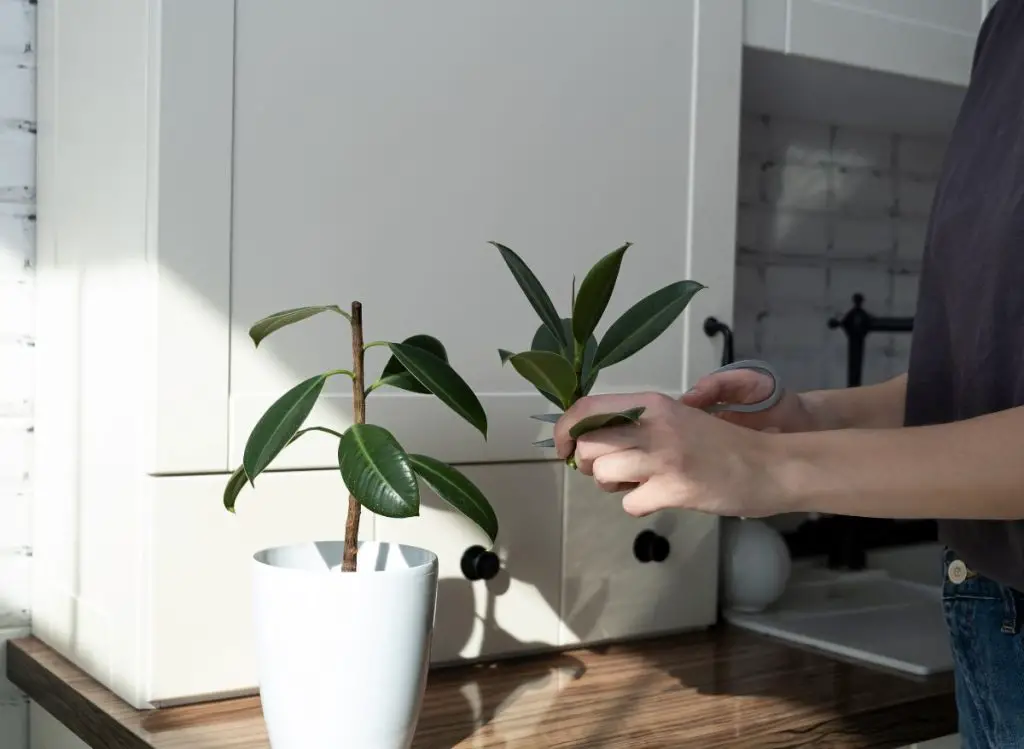
Rubber plants (Ficus elastica) are easy to grow and care for and thrive in different conditions, and they are perfect plants for beginners and another indoor plant that looks similar to an olive tree. They have dark green, glossy leaves with white stems, adding to their olive-like appearance.
Rubber plants grow 6 to 10 feet (1.83 to 3.05 meters) tall and can thrive in low light conditions, making them perfect for homes with limited sunlight (Source: Clemson University Cooperative Extension Service)
The Rubber Tree Plant is a beautiful houseplant that looks like an olive tree with its green, shiny leaves. It is low maintenance and can grow as tall as eight feet with proper care. It is also known for its ability to purify the air, making it an excellent choice for improving your home’s air quality.
The table below shows the growing characteristics of the Rubber Plant (Ficus elastica):
| Botanical Name | Ficus elastica ‘Variegata’ |
| Common names | – Variegata’ India-Rubber Fig – Variegata’ Rubber Tree |
| Family | Moraceae |
| Growth Rate | Fast |
| Mature size | 30 to 45 feet (9.14 to 13.72 meters) |
| Sunlight Requirement | – Partial shade – Full sun – Partial sun |
| Maintenance Requirements | Low |
| Soil Drainage | – Well-drained – Or occasionally wet |
| Best soil type | – Loam – Acidic – Alkaline – Sand – Clay |
| Potential Problems | – Resistant to pests and diseases |
9- Fiddle Leaf Fig (Ficus lyrata)

The fiddle-leaf fig is commonly grown and popular as a houseplant in the United States. Moreover, the Fiddle Leaf Fig has large, leathery leaves that resemble olive tree leaves. It is a vertical-growing plant that can reach 2 to 10 feet (0.61 to 3.01 meters) tall as a houseplant.
Though the fiddle-leaf fig requires a bit more maintenance and light, it will reward you with an elegant and eye-catching interior accent.
The table below shows the growing characteristics of the Fiddle Leaf Fig (Ficus lyrata):
| Botanical Name | Ficus lyrata |
| Common names | – Fiddle-leaf Fig – Banjo fig |
| Family | Moraceae |
| Growth Rate | Medium |
| Mature size | A 25 to 50 foot (7.62 to 15.24 meters) tall (Source: University of Florida) |
| Sunlight Requirement | Partial Shade, about 2 to 6 hours of direct sunlight per day |
| Maintenance Requirements | Low |
| Soil Drainage | – Moist – Good Drainage |
| Best soil type | – Sand – Loam (Silt) |
| Soil pH Requirements | Acid (pH level less than 6.0) |
| Potential Problems | – The fiddle leaf fig is resistant to insect pests or diseases. – As a houseplant, watch for scale, aphids, spider mites, mealy bugs, and thrips. – Potential diseases might be bacterial or fungal diseases. |
| USDA Plant Hardiness Zone | 10 to 12 |
What to read next:
- The Top Olive Trees that You Can Grow Indoors with Ease!
- Growing And Caring For Black Olive Tree: Everything you must know!
- Must Know For Growing and Caring For Olive Trees.
Wrapping Up
Indoor plants that look like olive trees are a great way to bring a touch of the Mediterranean to any indoor space.
Whether you opt for a ficus, a false olive plant, a dwarf umbrella tree, a variegated rubber plant, a fiddle leaf fig, and a rubber tree plant, there is sure to be an indoor plant that can evoke the charm of olive trees while thriving in the conditions of your home.
Remember, each plant has its own requirements for light, water, and care. By adding more indoor plants that look like olive trees, you can create a warm and welcoming environment that’s both healthy and beautiful.

